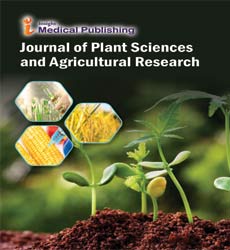Sustainable Crop Nutrition: The Role and Future of Fertilizers
Yang Li*
Department of Biological Sciences, Universidade Federal de Vicosa, Vicosa, Brazil
- *Corresponding Author:
- Yang Li
Department of Biological Sciences, Universidade Federal de Vicosa, Vicosa,
Brazil,
E-mail: li_ysde@ufdv.br
Received date: August 27, 2024, Manuscript No. IPJPSAR-24-19146; Editor assigned date: August 30, 2024, PreQC No. IPJPSAR-24-19146 (PQ); Reviewed date: September 12, 2024, QC No. IPJPSAR-24-19146; Revised date: September 19, 2024, Manuscript No. IPJPSAR-24-19146 (R); Published date: September 26, 2024, DOI: 10.36648/ipjpsar.8.3.155
Citation: Li Y (2024) Sustainable Crop Nutrition: The Role and Future of Fertilizers. J Plant Sci Agri Res Vol.8 No.3: 155.
Description
In the agricultural world, where every crop represents a potential harvest, the role of fertilizers cannot be overstated. Fertilizers, whether natural or synthetic, serve as the lifeblood of modern agriculture, ensuring that crops receive the essential nutrients required for robust growth and yield optimization. This review search into the significance of fertilizers exploring their types, benefits and potential environmental impacts.
Fertilizers come in various forms, each customized to meet specific agricultural needs. Broadly categorized into organic and inorganic types, fertilizers offer distinct advantages and drawbacks. Organic fertilizers, derived from natural sources like compost, manure and bone meal, provide a complete approach to soil enrichment, offering slow-release nutrients and improving soil structure over time. In contrast, inorganic or synthetic fertilizers are manufactured through chemical processes, offering rapid nutrient uptake and precise nutrient control. While both types have their merits, their selection often depends on factors such as crop type, soil condition and environmental considerations.
Fertilizers are essential nutrients applied to soil or plants to improve growth and productivity in agriculture. They typically contain a combination of nitrogen, phosphorus, and potassium, known as NPK, along with other micronutrients. Fertilizers can be organic, derived from natural sources like compost or manure, or synthetic, produced through chemical processes. Proper fertilizer application helps replenish soil nutrients, leading to increased crop yields and improved food security. However, overuse or improper application can lead to environmental issues such as nutrient runoff and water pollution.
The primary function of fertilizers is to replenish essential nutrients in the soil, thereby enhancing plant growth and productivity. Nitrogen, phosphorus and potassium, known as NPK, are the cornerstone nutrients found in most fertilizers, playing vital roles in plant metabolism, root development and disease resistance. By supplying these nutrients in optimal quantities, fertilizers facilitate improved crop yields, leading to enhanced food security and economic prosperity. Moreover, fertilizers enable farmers to cultivate a diverse range of crops in previously infertile or nutrient-depleted soils, thereby expanding agricultural potential and mitigating the effects of land degradation.
Environmental considerations
While fertilizers offer undeniable benefits, their indiscriminate use can pose environmental challenges. Excessive application of nitrogen-based fertilizers, for instance, can lead to nutrient runoff, contaminating water bodies and causing eutrophication - a phenomenon characterized by excessive algal growth and oxygen depletion. Similarly, phosphorus runoff from agricultural fields can contribute to the degradation of freshwater ecosystems, jeopardizing aquatic biodiversity and human health. To mitigate these environmental risks, sustainable fertilizer management practices such as precision agriculture, cover cropping and nutrient recycling are increasingly being adopted, emphasizing the importance of balanced nutrient application and soil conservation strategies.
As global population growth continues to strain agricultural resources, the demand for fertilizers is expected to escalate, necessitating innovative approaches to improve efficiency and sustainability. Emerging trends such as precision fertilization, bio-based fertilizers and nanotechnology offer promising avenues for optimizing nutrient delivery while minimizing environmental impacts. Furthermore, the integration of digital technologies such as remote sensing, machine learning and block chain into fertilizer supply chains holds the potential to revolutionize agricultural management, enabling real-time monitoring of soil health, crop nutrition and market dynamics.
Conclusion
Fertilizers represent indispensable tools in modern agriculture, enabling farmers to maximize crop yields and meet the evergrowing demands for food, feed and fiber. While their benefits are undeniable, responsible fertilizer use is imperative to safeguard environmental integrity and long-term agricultural sustainability. By embracing innovative technologies and adopting complete approaches to nutrient management, stakeholders can harness the full potential of fertilizers to cultivate a greener, more resilient future for generations to come.
Open Access Journals
- Aquaculture & Veterinary Science
- Chemistry & Chemical Sciences
- Clinical Sciences
- Engineering
- General Science
- Genetics & Molecular Biology
- Health Care & Nursing
- Immunology & Microbiology
- Materials Science
- Mathematics & Physics
- Medical Sciences
- Neurology & Psychiatry
- Oncology & Cancer Science
- Pharmaceutical Sciences
